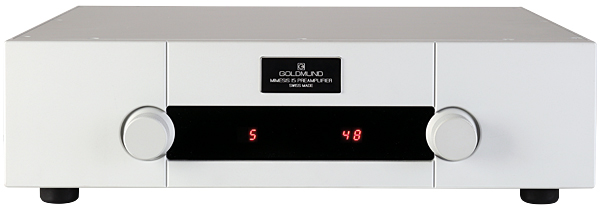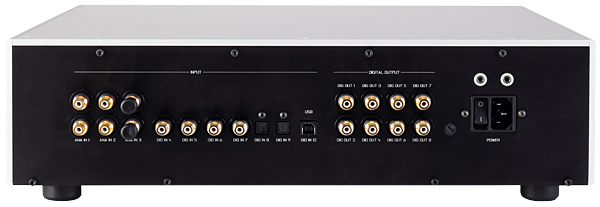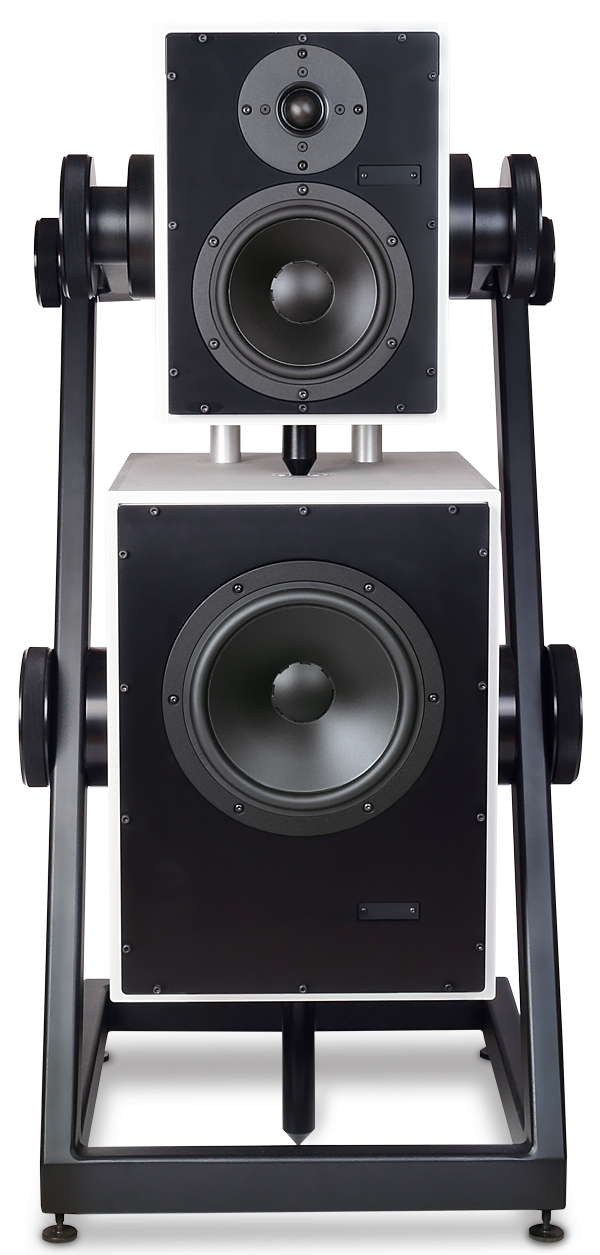Goldmund Mimesis 15/Prana Active Loudspeaker Page 2
The Mimesis 15 processor is simple to use, with no more than a volume control, an input selector and a remote control. Inputs extend to three analogue line-ins, passing through a 96kHz/24-bit ADC, and four coaxial and two optical digital ins also accommodating files up to 96kHz, and a USB-B for direct connection from a computer (or, in our case, a Melco Digital Music Library).

All good so far, except the USB input is limited to 48kHz, which will be fine for those who only ever play CDs – or CD-quality files. A hard drive full of high-res files will not leave you with the sound of silence, however, because all correctly-engineered USB sources, including the Melco N1ZS20/2 [HFN Jun '17], will 'handshake' with the Prana USB sink and automatically downsample their output from 96kHz, 192kHz, etc, to the 48kHz required. If you're listening off a PC or Mac, you should also be able to force a 48kHz output from your media player of choice.
![]() Big Picture
Big Picture
From the outset the Mimesis 15/Prana combination proved very listenable indeed, and without a doubt able to convey a broad brush of the music, even if its balance was a little soft and safe-sounding at lower listening levels. Whipping off those substantial box-framed grilles certainly brought back more bite and sparkle and playing a range of music left me in no doubt that these speakers were doing some good things in terms of presenting the music's big picture. Nevertheless, perhaps they really weren't really delivering masses of detail when it came to vocal and instrumental timbres and textures.

Tiger Tank
There's good weight in the bass, even at lowish levels (PM noted this meant at around 52 on the Mimesis 15's 'goes to 99' scale) but while there's reasonable midband and treble information, the things I tend to listen for in a good recording – meaning coherent, focused soundstaging and a sense of space, air and ambience in the presentation – were just a little muted here.
The sound down in the sensible zone is arguably a tad dark and, on occasion, slightly gloomy, even with a highly atmospheric recording such as Mike Oldfield's Return To Ommadawn [Virgin EMI CDV3166] where the, quite literally, multi-layered instrumentation is usually crisply defined and precisely placed in the soundstage.
Via the Goldmund Pranas running at 'polite' levels it's all a bit loose and uninvolving in hi-fi terms, though very listenable without a hint of strain. Increase the volume, however, and the Prana's suggest there's a tiger slumbering in the tank as Oldfield's strings and keyboards start to take flight into the room, with a deal more life and energy. But turn up the juice too far and the tiger is just as likely to reach out and give you a swipe.
Similarly, the speakers prove adept with simple jazz. Even slightly larger ensembles, including Joe Stilgoe's 'Mr Spiggott' from his I Like This One album [Candid CCD 79851], has plenty of speed and pace, but again the sound at normal listening levels was rather 'general' for my tastes, instead of being tightly focused. That sense of the 'band in the room' usually on offer with this intimate, crisply recorded set was rendered a little too conservatively.

Scale And Power
And the same happens with Kyle Eastwood's driving 'Bullet Train' from his Time Pieces set [Jazz Village JV 570034]. Again there's that strange mix of plenty of drive in the bass, with Eastwood's instrument grumbling away, even though the brass of Quentin Collins and Brandon Allen lacks a little interest. Oh well, maybe turning it up a bit again might help, not that there's actually any lack of room-filling ability here.
Do so and, in this instance, the brass on that Eastwood track goes from 'Ho hum' to 'Holy…', with an unexpectedly aggressive, attacking sound. Much more satisfying, perhaps, but also with more than a hint of stridency about it that could prove fatiguing in the long-term. Yes, you'll probably be enjoying that the sofa now seems to be moving beneath you – that 180mm bass unit really works for its living – but what you're still not getting is much of an infill of the soundstage, let alone that 'point at the performer' effect.
What these speakers deliver is all the scale and power of the music – as much as that CD-quality limitation on the USB input will allow. Playing the Scottish Chamber Orchestra's recording of the overture to Mozart's Così Fan Tutte [from Linn Records CKD 460], the Pranas' rhythmic ability certainly sweeps the listener along with the music, while there's entirely appropriate weight and scale to the sound.
Yet for the diehard audiophile, the Pranas may be found to lack that vital blend of musical force and window into the event that's the hallmark of many a fine, if conventional and less convenient, set-up of amp and speakers.
Hi-Fi News Verdict
There's a lot going on in these speakers, from the digital wireless input to the onboard amps and extensive computer modelling in their design, even it doesn't all quite hang together in pure high-end hi-fi terms. I suspect that won't trouble the target market one jot: the sound in 'cruise mode' is fulsome, conveying the big picture of the music well, and they'll undoubtedly go as loud as required when it's party time.

















































